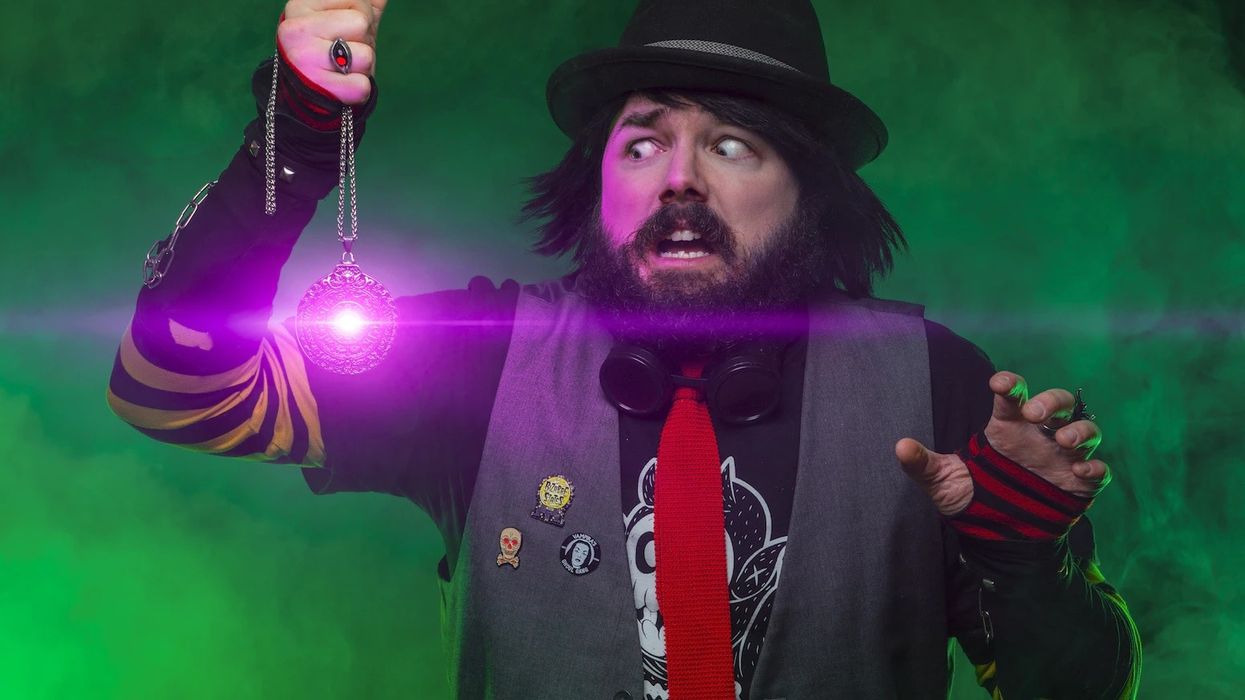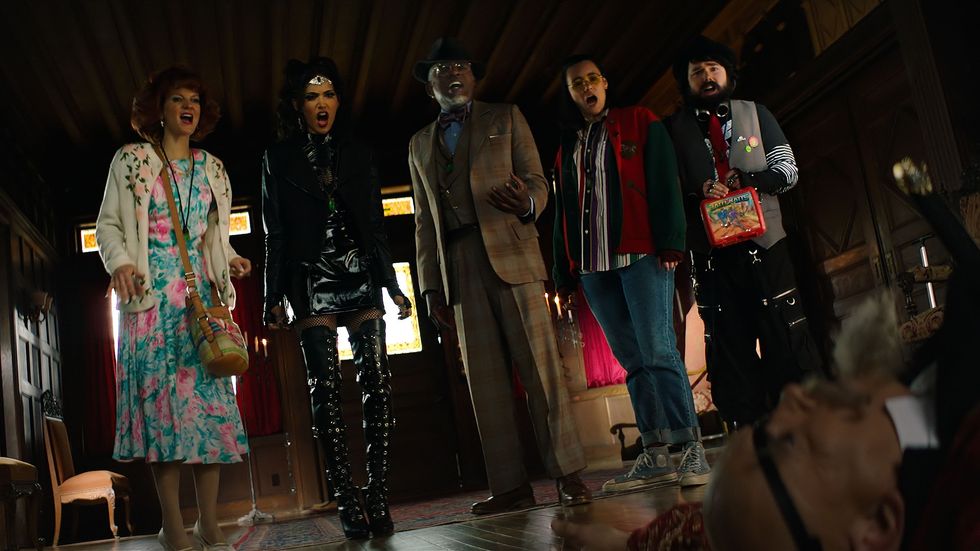How a Sundance Multi-Hyphenate Embraced Viral Stardom
Andrew Bowser wrote, directed, edited, and starred in a film based on a viral character of his own making and found his way into Sundance.

'Onyx the Fortuitous & the Talisman of Souls'
Multi-hyphenate creatives are not a new breed in the modern age of filmmaking. It feels like to get anything made these days. You have to write, direct, and produce your own films to even get them off the page.
This is exactly what Andrew Bowser did to create his film Onyx the Fortuitous and the Talisman of Souls, which premiered at Sundance and will have a limited release in Los Angeles on October 19.
But Bowser's journey included a few extra hats and spanned almost a decade. We chatted with him for the No Film School Podcast to learn all the ins and outs of his adventure to bring Onyx to the big screen.
Embracing Viral Stardom
The titular character of Onyx the Fortuitous and the Talisman of Souls began his life almost a decade ago. While most may know him as Weird Satanist Guy, Onyx was first introduced to the world as Weird Arby's Guy.
"The first Onyx video was Weird Gamer Guy," Bowser said. "But then, right after that, was Weird Satanist Guy. But a lot of people didn't meet him until the third video, which was Weird Arby's Guy. But I met him a few months before Weird Gamer Guy. I had been taking improv classes at UCB."
What began as an exercise anchoring a character with a tick became a viral sensation on YouTube, with each video garnering millions of views. At the time, Bowser was producing and editing for different "nerdy video outlets," as he called them.
"At the time, I was working for Break.com, and we were going to a lot of conventions, filming at Comic Con, filming at E3. And I remember one day after improv class, I had an idea for a character who had a nervous tick that he would say, I don't know, no matter what he had just said, even if it was something he was very certain of."
The catchphrase caught on and birthed the character of Onyx, which gave Bowser an outlet to pursue his creativity as an actor.
"I felt like I had found something to pursue just creatively," Bowser said. "I was curious about this guy. And so I wrote the script for Weird Gamer Guy, and when we shot it, you know, that's where a lot of the tropes of Onyx were dialed in."
Bringing Onyx to life on the big screen only took a couple of years, but Bowser's journey as a director was formed during his trials and tribulations as a child actor in Washington, D.C.
The Long Road To Sundance
"I was a child actor in Washington D.C.," Bowser explained. "But I hated auditioning. I really didn't like the insecurity I felt when auditioning and how quickly things could be changed on me. Somebody could all of a sudden say, 'Oh, we're not doing those sides. Oh, you didn't get the new sides? No, here's the new sides.' And then all of a sudden, I'm a nine-year-old doing a cold read for a feature or a Broadway play."
This led Bowser to write and direct his own material "purely out of a want for more control," with several films predating his most recent work.
"I'd made three other feature films, and they were all arguably experimental," Bowser said. "One was a mockumentary, one was found footage, and one was shot entirely on a GoPro done in two takes with an actor wearing a SnooriCam where the camera's attached to their chest."
While these films had successful festival runs, Bowser still couldn't get an Onyx film made.

'Onyx the Fortuitous & the Talisman of Souls'
Credit: Fathom Events
"I tried to fit Onyx into other people's companies and studios over the years when they were looking for pitches," Bowser said. "So could Onyx be Ali G? Maybe. Well, hey, [The] Eric Andre [Show] is big or Jackass, could Onyx have a prank show? And I had pitched all these Onyx projects over the years just because someone was looking for something, but not Onyx. They weren't looking for whatever Onyx project I truly cared about."
This is what brought Bowser to the wonderful yet often difficult world of crowdfunding. While producers didn't know how to bring Onyx to life, its creator knew there was an audience. Millions of people had seen him on YouTube, so there was already an audience.
Gamifying Crowdfunding
Using his experience in the YouTube space, Bowser carefully watched the reception to the Kickstarter campaign. Throughout the run, there were peaks and valleys. When attention for the project dropped, Bowser would release new milestones or pledges.
"My kind of producorial mind really liked the gamification of a campaign," Bowser said. "Building out a schedule of okay, two weeks in, we're gonna do this kind of stunt, we're gonna do a live read this many weeks in, and we're gonna have it like a telethon with people in chat helping to raise money."
And when the campaign did hit one of those valleys, Bowser had a plan. "Oh, we're hitting a lull. I'm gonna release a pin that says fight the lull, and people will raise their pledge to get that pin."
Bring It All Together In Adobe
For Bowser and his team, production was as calculated as his process for funding his film. Plans were made for the opportunity to pivot if the schedule ran long, and a pivot halfway through the project brought several of the characters to life as puppets.
But when all was said and done, Bowser was left with a lot of footage and a brand new timeline within Adobe Premiere Pro. With years of experience working for the nerdy video outlets, Bowser took the task of editing entirely upon himself.
The one thing that always fascinated me about all the editors we interviewed was how different each creative is in their approach to editing. While some may use a massive amount of shortcuts or develop their own custom workflow, Bowser was content with one tool.
"I could talk about editing all day from an artistic standpoint and from a rhythmic standpoint and a pacing standpoint, but all I do when I edit is I use the Blade Tool, and that's it," Bowser said.

'Onyx The Fortuitous and the Talisman of Souls'
Credit: Fathom Events
This simple approach came from his years in film school, where Bowser started editing on a linear film editor before moving to digital.
"My editing teacher in film school, Vincent Labrudo, the sequences that he would show us were so big on fluid editing, editing on action, you know, editing should be invisible, et cetera, et cetera, but it should still have an impact," Boweswer said. "It should be something subconscious."
While we always try to lean on our tools, sometimes simplicity is key when editing a film. Using the varied toolkit within Premiere Pro, Bowser also brought this simplicity to using temp audio and VFX.
"I do a lot of temp audio. I'll plug in my mic and just let it run, and I'll do sound effects, and I'll add in temp ADR for other actors," Bowser said. "I'll map in some real rudimentary things for VFX."
"But ultimately, editing for me is just, you know, slicing and splicing."
Advice For Filmmakers in 2023
Having championed a film of his very own, while also starring, directing, and editing, I wondered what advice Bowser would have for creatives who were in his position—those creatives who dreamed of Sundance.
"A big lesson I've learned, and this can be dangerous, but a big lesson I've learned is to not turn your nose up at any specific platform," Bowser explained. "I think it was my job at Nerdist that made me understand that these different platforms were nothing to look down on. I can utilize them for my own means."
The lesson is a hard one we must all learn. The industry is always evolving, and the platforms are always shifting. But the work remains the same.
"The work is what you make of it," Bowser said. "Somebody could say, 'Well, this is a YouTuber who made a movie,' or somebody could say, 'This is a TikTokker who made a movie,' or somebody could say, 'This is a 41-year-old filmmaker who learned to cut on film and went to school in the year 2000, who had to pivot and put his work on different platforms because of the ever-changing landscape of the industry."
It's all about giving our creative inner artist an opportunity to, well, be an artist.
"I can keep storytelling structure pacing at the center of my interests while I'm putting content out on TikTok," Bowser said. "The fact that I had a character that could do a silly dance and get a million views, but then those viewers could go to Kickstarter to help fund my feature, it's a little bit of me gaming the system to get what filmmaker Andrew has wanted since he was eight years old."
With that advice, I think we should all go and figure out how to give our eight year old selves what we've always wanted out of film.











